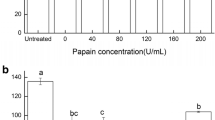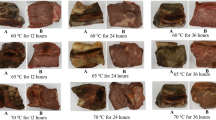Abstract
This study investigated the effect of hydrostatic pressure processing (HPP) on post-rigor mortis beef (Longissimus dorsi muscle, Nelore breed) relevant parameters, such as texture, cooking loss, and color. Pressures varying from 100 to 400 MPa at different times of pressurization (T1: time to reach set pressure, and T2: T1 plus 15 min) were applied, immediately followed by depressurization. Samples were evaluated for color, cooking loss, and tenderness. Both pressure level and pressurizing time had an effect on the color, cooking loss, and tenderness. Low-pressure levels (up to 200 MPa) had a smaller impact on color; nevertheless, it improved tenderness. The cooking loss increased with increased levels of pressure; however, by increasing pressure to 100 and 200 MPa immediately followed by pressure release (T1), no significant differences were observed when compared to the results from unpressurized samples. On the other hand, cooking loss was higher in the beef pressurized at all pressure levels for 15 min (T2). The results show that treatments using lower pressures (100 to 200 MPa) can potentially contribute to Zebu meat quality improvement.


Similar content being viewed by others
References
Addinsoft (2012). XLSTAT statistical analysis software. Version 2012.
AMSA. (1995). Research guidelines for cookery, sensory evaluation, and instrumental tenderness of fresh meat. Chicago: American Meat Science Association and National Livestock and Meat Board.
Bajovic, B., Bolumar, T., & Heinz, V. (2012). Quality considerations with high pressure processing of fresh and value added meat products. Meat Science, 92, 280–289.
Bowers, L. J., Dikeman, M. E., Murray, L., & Stroda, S. L. (2012). Cooked yields, color, tenderness, and sensory traits of beef roasts cooked in an oven with steam generation versus a commercial convection oven to different endpoint temperatures. Meat Science, 92, 97–106.
Bowker, B. C., Liu, M., Solomon, M. B., Eastridge, J. S., Fahrenholz, T., & Vinyard, B. T. (2007). Effects of hydrodynamic pressure processing and blade tenderization on intramuscular collagen and tenderness-related protein characteristics of top rounds from Brahman cattle. Journal of Muscle Foods, 18(1), 35–55.
Bowker, B. C., Fahrenholz, T. M., Paroczay, E. W., Eastridge, J. S., & Solomon, M. B. (2008). Effect of hydrodynamic pressure processing and aging on the tenderness and myofibrillar proteins of beef strip loins. Journal of Muscle Foods, 19, 74–97.
Carlez, A., Veciana-Nogues, T., & Cheftel, J. C. (1995). Changes in colour and myoglobin of minced beef meat due to high pressure processing. Lebensmittel-Wissenschaft und-Technologie, 28(5), 528–538.
Cheftel, J., & Curioli, J. (1997). Effects of high pressure on meat: a review. Meat Science, 46, 211–236.
Crehan, C. M., Troy, D. J., & Buckley, D. J. (2000). Effects of salt level and high hydrostatic pressure processing on frankfurters formulated with 1.5 and 2.5 % salt. Meat Science, 55, 123–130.
Denoyellea, C., & Lebihan, E. (2003). Intramuscular variation in beef tenderness. Meat Science, 66, 241–247.
Felício, P. E. (1999). Beef quality: Physical and organoleptic characteristics. In: Annual Meeting of the Brazilian Society of Animal Science. Porto Alegre. Proceedings of the symposium and workshop, 36, 89–97. Porto Alegre, Brazil.
Goutefongea, R., Rampon, V., Nicolas, N., & Dumont, J.P. (1995). Meat colour changes under high pressure treatment. In 41st Intl. Congress of Meat Science and Technology, 41, 19–21. National Livestock and Meat Board, San Antonio, Texas, USA.
Hope-Jones, M., Strydom, P. E., Frylinck, L., & Webb, E. C. (2010). The efficiency of electrical stimulation to counteract the negative effects of ß-agonists on meat tenderness of feedlot cattle. Meat Science, 86, 699–705.
IBGE (2012). Brazilian Institute of Geography and Statistics. Available in http:/www.ibge.gov.br/home/presidencia/default_ant.php. Access on 30th Oct 2012.
Joo, S. T., Kauffman, R. G., Kim, B. C., & Park, G. B. (1999). The relationship of sarcoplasmic and myofibrillar protein solubility to colour and water holding capacity in porcine longissimus muscle. Meat Science, 52, 291–297.
Jung, S., Lambllerie-Anton, M., & Ghoul, M. (2000). Textural changes in bovine meat treated with high pressure. High Pressure Research, 19, 69–74.
Jung, S., Ghoul, M., & Lamballerie-Anton, M. (2003). Influence of high pressure on the color and microbial quality of beef meat. Lebensmittel-Wissenschaft und-Technologie, 36(6), 625–631.
Kennick, W. H., Elgasim, E. A., Holmes, Z. A., & Meyer, P. F. (1980). The effect of pressurization of pre-rigor muscle on post-rigor meat characteristics. Meat Science, 40, 33–40.
Kim, Y. J., Lee, E. J., Lee, N. H., Kim, Y. H., & Yamamoto, K. (2007). Effects of hydrostatic pressure treatment on the physiochemical, morphological, and textural properties of bovine semitendinosus muscle. Food Science and Biotechnology, 16, 49–54.
Locker, R. H., & Wild, D. J. C. (1984). Tenderization of meat by pressure-heat involves weakening of the gap filaments in myofibrils. Meat Science, 10, 207–233.
Ma, H. J., & Ledward, D. A. (2004). High pressure/thermal treatment effects on the texture of beef muscle. Meat Science, 68, 347–355.
Mandava, R., Fernandez, I., & Juillerat, M. (1994). Effect of high hydrostatic pressure on sausage batters. In: Proceedings of 40th International Congress of Meat Science and Technology. S-VIB. 11, 1–6. The Hague, Holland.
MAPA (2004). Brazilian System of Carcass Classification. Normative Instruction No. 9, 04/05/2004. Available at: www.cda.sp.gov.br/www/legislacoes/popup.php?action=view&idleg=643. Accessed 2 Mar 2014.
Marcos, B., Kerry, J. P., & Mullen, A. M. (2010). High pressure induced change on sarcoplasmic protein fraction and quality indicators. Meat Science, 85, 115–120.
McArdle, R., Marco, B., Kerry, J. P., & Mullen, A. (2010). Monitoring the effects of high pressure processing and temperature on selected beef quality attributes. Meat Science, 96, 629–634.
Mussa, D. M. (1999). High pressure processing of milk and muscle foods: evaluation of process kinetics, safety and quality changes. PhD thesis, McGill University, Canada.
Papadakis, S. E., Abdul-Malek, S., Kamdem, R. E., & Yam, K. L. (2000). A versatile and inexpensive technique for measuring color of foods. Food Technology, 54(12), 48–51.
Riffero, L. M., & Holmes, Z. A. (1983). Characteristics of pre-rigor pressurized versus conventionally processed beef cooked by microwave and by boiling. Journal of Food Science, 48, 346–372.
Shigehisa, T., Ohmori, T., Saito, A., Taji, S., & Hayashi, R. (1991). Effects of high hydrostatic pressure on characteristics of pork slurries and inactivation of microorganisms associated with meat and meat products. International Journal of Food Microbiology, 12, 207–216.
Sikes, A., Tormberg, E., & Tume, R. A. (2010). Proposed mechanism of tenderising post-rigor beef using high pressure–heat treatment. Meat Science, 84, 390–399.
Solomon, M. B., Liu, M., Patel, J. R., Bowker, B. C., & Sharma, M. (2006). Hydrodynamic pressure processing to improve meat quality and safety. In: Nollet, L. M. L., Toldra, F., editors. Advanced Technologies for Meat Processing. Boca Raton, FL: CRC Press, Taylor & Francis Group. 219–244.
Strydom, P. E. (2011). Quality related principles of the South African beef classification system in relation to grading and classification systems of the world. South African Journal of Animal Science, 41, 177–194.
Sun, X. D., & Holley, R. A. (2010). High hydrostatic pressure effects on the texture of meats and meats products. Journal of Food Science, 75, 1.
Suzuki, A., Watanabe, M., Iwamura, K., Ikeuchi, Y., & Saito, M. (1990). Effects of high pressure treatment on the ultrastructure and myofibrillar protein of beef skeletal muscle. Agricultural and Biological Chemistry, 54, 3085–3091.
U.S. Department of Agriculture (2014). USDA livestock and poultry: world markets and trade. Web Site: http://www.fas.usda.gov/data/livestock-and-poultry-world-markets-and-trade. (Accessed 30/05/2014).
Acknowledgments
The authors thank CAPES and FAPERJ for the financial support.
Author information
Authors and Affiliations
Corresponding author
Rights and permissions
About this article
Cite this article
Neto, O.C., Rosenthal, A., Deliza, R. et al. Effects of Hydrostatic Pressure Processing on Texture and Color of Zebu Beef. Food Bioprocess Technol 8, 837–843 (2015). https://doi.org/10.1007/s11947-014-1451-2
Received:
Accepted:
Published:
Issue Date:
DOI: https://doi.org/10.1007/s11947-014-1451-2




